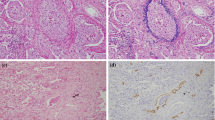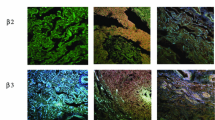Abstract
Background
Experimental studies have revealed that D2-40 is useful in identifying the presence of lymphatic invasion in various malignant neoplasms, but the clinical significance remains unclear. The purpose of this study is to assess the clinical significance of D2-40 status in completely resected non–small cell lung cancer.
Methods
A total of 215 consecutive patients with resected pathological stage I–IIIA non–small cell lung cancer were reviewed. Expression of D2-40 in tumor cells and in endothelial cells was examined immunohistochemically, and D2-40-positive lymphatic vessel density (LVD) at the tumor periphery were quantitatively evaluated.
Results
D2-40 expression on tumor cells was positive in 55 (25.6%) of 215 patients, and the incidence was significantly higher in squamous cell carcinoma (SCC) patients than in adenocarcinoma patients (48.8% vs. 8.6%, P < .001). D2-40 was also seen on lymphatic vessels in tumor tissues, and the mean number of D2-40-LVD was significantly decreased along with differentiation of tumor cells (P = .038). For all histologic types of tumors, there was no difference in the postoperative survival between higher D2-40-LVD patients and lower D2-40-LVD patients. For SCC, however, lower D2-40-LVD patients showed a significantly better survival than higher D2-40-LVD patients (5-year survival rates, 52.9% vs. 78.9%, P = .040), which was confirmed by a multivariate analyses (P = .048).
Conclusions
D2-40 expression on tumor cells was more frequently seen in SCC than in adenocarcinoma of the lung. In addition, D2-40 expression on lymphatic vessels in tumor tissues was a statistically significant prognostic factor in SCC.



Similar content being viewed by others
References
Pearson FG. Non-small cell lung cancer: role of surgery for stages I–III. Chest. 1999;116:500–3.
Mountain CF. Revisions in the international system for staging lung cancer. Chest. 1997;111:1710–7.
Marks A, Sutherland DR, Bailey D, et al. Characterization and distribution of an oncofetal antigen (M2A antigen) expressed on testicular germ cell tumours. Br J Cancer. 1999;80:569–78.
Kahn HJ, Bailey D, Marks A. Monoclonal antibody D2-40, a new marker of lymphatic endothelium, reacts with Kaposi’s sarcoma and a subset of angiosarcomas. Mod Pathol. 2002;15:434–40.
Franke FE, Steger K, Marks A, Kutzner H, Mentzel T. Hobnail hemangiomas (targetoid hemosiderotic hemangiomas) are true lymphangiomas. J Cutan Pathol. 2004;31:362–7.
Kahn HJ, Marks A. A new monoclonal antibody, D2-40, for detection of lymphatic invasion in primary tumors. Lab Invest. 2002;82:1255–7.
Nisato RE, Tille JC, Pepper MS. Lymphangiogenesis and tumor metastasis. Thromb Haemost. 2003;90:591–7.
Müller AM, Franke FE, Müller KM. D2-40: a reliable marker in the diagnosis of pleural mesothelioma. Pathobiology. 2006;73:50–4.
Renyi-Vamos F, Tovari J, Fillinger J, et al. Lymphangiogenesis correlates with lymph node metastasis, prognosis, and angiogenic phenotype in human non-small cell lung cancer. Clin Cancer Res. 2005;11:7344–53.
Takanami I. Lymphatic microvessel density using D2-40 is associated with nodal metastasis in non–small cell lung cancer. Oncol Rep. 2006;15:437–42.
Okudera K, Kamata Y, Takanashi S, et al. Small adenocarcinoma of the lung: prognostic significance of central fibrosis chiefly because of its association with angiogenesis and lymphangiogenesis. Pathol Int. 2006;56:494–502.
Travis WD, Colby TV, Corrin B, Shimosato Y, Brambilla E. Histological typing of lung and pleural tumors. In: Travis WD, editor. World Health Organization international histological classification of tumors. 3rd ed. Berlin: Springer, 1999:21–66.
Vermeulen PB, Gasparini G, Fox SB, et al. Quantification of angiogenesis in solid human tumours: an international consensus on the methodology and criteria of evaluation. Eur J Cancer. 1996;32:2474–84.
Miyahara M, Tanuma J, Sugihara K, Semba I. Tumor lymphangiogenesis correlates with lymph node metastasis and clinicopathologic parameters in oral squamous cell carcinoma. Cancer. 2007;110:1287–94.
Saad RS, Kordunsky L, Liu YL, et al. Lymphatic microvessel density as prognostic marker in colorectal cancer. Mod Pathol. 2006;19:1317–23.
Yonemura Y, Endou Y, Tabachi K, et al. Evaluation of lymphatic invasion in primary gastric cancer by a new monoclonal antibody, D2-40. Hum Pathol. 2006;37:1193–9.
Mori D, Yamasaki F, Shibaki M, Tokunaga O. Lateral peritumoral lymphatic vessel invasion can predict lymph node metastasis in esophageal squamous cell carcinoma. Mod Pathol. 2007;20:694–700.
Gombos Z, Xu X, Chu CS, Zhang PJ, Acs G. Peritumoral lymphatic vessel density and vascular endothelial growth factor C expression in early-stage squamous cell carcinoma of the uterine cervix. Clin Cancer Res. 2005;11:8364–71.
Fogt F, Zimmerman RL, Ross HM, Daly T, Gausas RE. Identification of lymphatic vessels in malignant, adenomatous and normal colonic mucosa using the novel immunostain D2-40. Oncol Rep. 2004;11:47–50.
Saad RS, Lindner JL, Lin X, Liu YL, Silverman JF. The diagnostic utility of D2-40 for malignant mesothelioma versus pulmonary carcinoma with pleural involvement. Diagn Cytopathol. 2006;34:801–6.
Adachi Y, Nakamura H, Kitamura Y, et al. Lymphatic vessel density in pulmonary adenocarcinoma immunohistochemically evaluated with anti-podoplanin or anti-D2-40 antibody is correlated with lymphatic invasion or lymph node metastases. Pathol Int. 2007;57:171–7.
Ordóñez NG. D2-40 and podoplanin are highly specific and sensitive immunohistochemical markers of epithelioid malignant mesothelioma. Hum Pathol. 2005;36:372–80.
Padera TP, Kadambi A, di Tomaso E, et al. Lymphatic metastasis in the absence of functional intratumor lymphatics. Science. 2002;296:1883–6.
Arnaout-Alkarain A, Kahn HJ, Narod SA, Sun PA, Marks AN. Significance of lymph vessel invasion identified by the endothelial lymphatic marker D2-40 in node negative breast cancer. Mod Pathol. 2007;20:183–91.
Van den Eynden GG, Van der Auwera I, Van Laere SJ, et al. Distinguishing blood and lymph vessel invasion in breast cancer: a prospective immunohistochemical study. Br J Cancer. 2006;94:1643–9.
Shields JD, Borsetti M, Rigby H, et al. Lymphatic density and metastatic spread in human malignant melanoma. Br J Cancer. 2004;90:693–700.
Acknowledgment
We thank Seiko Sakai for her assistance in preparing the manuscript.
Author information
Authors and Affiliations
Corresponding author
Rights and permissions
About this article
Cite this article
Iwakiri, S., Nagai, S., Katakura, H. et al. D2-40-Positive Lymphatic Vessel Density Is a Poor Prognostic Factor in Squamous Cell Carcinoma of the Lung. Ann Surg Oncol 16, 1678–1685 (2009). https://doi.org/10.1245/s10434-009-0432-6
Received:
Revised:
Accepted:
Published:
Issue Date:
DOI: https://doi.org/10.1245/s10434-009-0432-6




